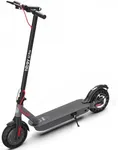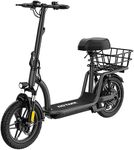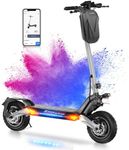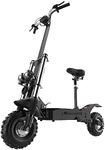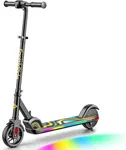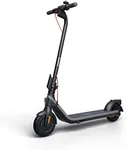Buying Guide for the Best Electric Scooter For Climbing Hills
Choosing an electric scooter for climbing hills requires a bit more attention to certain features than picking a scooter for flat city rides. Hills put extra strain on the motor and battery, so you need a scooter that can handle steeper inclines without losing too much speed or running out of power quickly. Think about the steepness of the hills you plan to climb, your own weight, and how far you want to travel on a single charge. By understanding the key specifications, you can find a scooter that will make hill climbing smooth and enjoyable.Motor Power (Wattage)Motor power, measured in watts (W), tells you how strong the scooter’s engine is. This is especially important for climbing hills, as a more powerful motor can handle steeper inclines and heavier riders without slowing down too much. Motors under 300W are best for flat surfaces and gentle slopes, while 300W to 500W can manage moderate hills for most riders. For steep hills or heavier users, look for scooters with 600W or more. To pick the right motor power, consider the steepest hills you’ll face and your own weight—if you’re heavier or have very steep hills, go for higher wattage.
Battery Capacity (Ah or Wh)Battery capacity, shown in ampere-hours (Ah) or watt-hours (Wh), tells you how much energy the scooter can store. Climbing hills uses more energy than riding on flat ground, so a bigger battery means you can go farther without needing to recharge. Small batteries (under 7Ah or 250Wh) are fine for short, flat trips, while medium batteries (7-12Ah or 250-450Wh) suit moderate hills and average distances. For long rides on hilly terrain, look for larger batteries (over 12Ah or 450Wh). Choose a battery size based on how far you want to travel and how many hills you’ll climb.
Climbing Angle (Incline Percentage or Degrees)The climbing angle tells you the steepest hill the scooter can handle, usually given as a percentage or in degrees. A higher number means the scooter can climb steeper hills. Scooters with a climbing angle of 10% (about 6 degrees) are good for gentle slopes, 15-20% (8-11 degrees) for moderate hills, and 20% or more (over 11 degrees) for steep hills. Think about the steepest hill you’ll regularly climb and make sure the scooter’s climbing angle matches or exceeds it.
Weight CapacityWeight capacity is the maximum load the scooter can safely carry, including the rider and any gear. If you’re close to or over the limit, the scooter will struggle more on hills and may wear out faster. Lighter riders can use scooters with lower weight limits, but heavier riders should look for higher capacities. Always choose a scooter with a weight limit that’s at least 10-20% higher than your own weight for the best performance on hills.
Tire Size and TypeTire size and type affect how well the scooter grips the road and handles bumps, especially on hills. Larger tires (8 inches or more) and pneumatic (air-filled) tires provide better traction and a smoother ride on steep or uneven surfaces. Smaller or solid tires are fine for flat, smooth roads but may slip or feel rough on hills. If you’ll be climbing hills often, especially on rough or wet roads, choose a scooter with larger, air-filled tires.
Braking SystemA good braking system is crucial for safety, especially when going downhill after a climb. Scooters may have electronic, disc, drum, or foot brakes. Disc and drum brakes offer stronger, more reliable stopping power, which is important on steep descents. Electronic and foot brakes are better for flat areas or gentle slopes. If you’ll be riding on hilly terrain, look for a scooter with at least one disc or drum brake for safe stopping.

